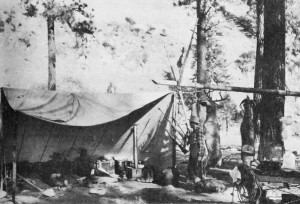In the first part of this series we covered how classic books about the outdoors can stand the test of time purely for their entertainment value to readers, particularly the enjoyment that is can be had from the stories of hunting and fishing.
The second part of the series is similar to the first part, but instead of deriving enjoyment from stories of trophy elk or trout, the enjoyment comes from connecting to another time. Granted, these books are not that old, ranging anywhere from fifty to one hundred years old, but to many people, it’s an era that holds a certain level of fascination. Whether the fascination stems from learning how your father hunted, how your grandfather hunted, or remembering how you hunted as a youth, the fascination is undeniable and these books provide a way to learn about the history of hunting.
Some people are simply captivated by how things were done in the past, even if they have no intention of using those tools and techniques in their own sporting excursions. For people like that, classic books about the outdoors are a goldmine of information. Almost all of these books cover in great detail the tools used for the particular subject—rifles, cartridges, clothing, rods, reels, lures, tents, packs, etc.—so that one can get a complete picture of how hunting, fishing, or match shooting was done decades ago.

Examples of books of this kind are ample, the most notable being Wilderness Hunting and Wildcraft by Townsend Whelen, Keith’s Rifles for Large Game by Elmer Keith, and Rifle-Craft by C. S. Landis—currently the oldest book published we publish, dating from 1923.

One of the more unique books that comes to mind for its historical value is This Business of Exploring by Roy Chapman Andrews. While this book is not about hunting or fishing or any other sportsman-like pursuit, it remains a fascinating account of a bygone era. The book is about one of the expeditions of the author, a noted explorer, in his search for fossils and other artifacts in Mongolia in the late 1920’s. In the book, Andrews writes of death, war, and groundbreaking discoveries in an age of scientific exploration which no longer exists. Reading almost like the journal of a real-life Indiana Jones, Andrews’ book has tons of entertainment and historical significance.

Smith & Wesson Hand Guns by Walter Roper and Roy McHenry is a book written about the history of the Smith & Wesson Company from the founding of the company through World War II. This particular book was written from the ground up as a historical account and has been used by Smith & Wesson collectors as a reference for decades, as the book contains a fair amount of detail on the changes to each Smith & Wesson model through the years.

Elmer Keith makes reference to Smith & Wesson Hand Guns many times in his own brief historical account of the revolver—which can be found in Sixguns—and Keith’s history of the revolver is itself a valuable reference work to firearms historians as a secondary source, since Keith personally interacted with Civil War veterans and other Old West survivors.

It is impossible to deny that these books are valuable to those of us who read books for their historical content. From learning how things were done by a prior generation, to learning about the founding of a company and the technological advancements of firearms, these books have it covered.
In the final part of this series we will discuss the practical value of classic sporting books.